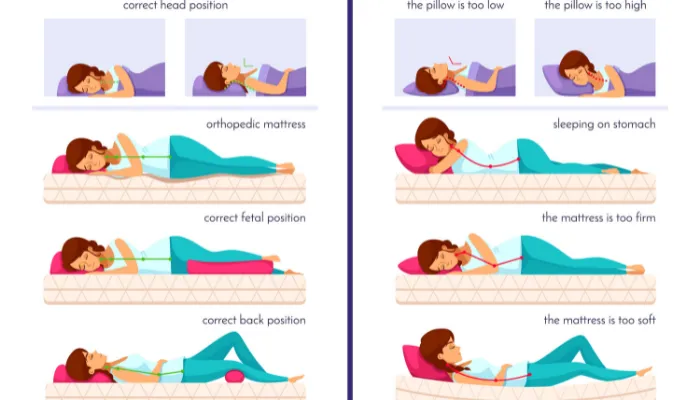Having a mattress for good sleep is one of the most important things for a healthy life. A night of good sleep in turn is decided by the mattress as it is the one that provides the required support and comforts the body needs to relax. Yet, the significance of the mattress is either overlooked or not realized at all.
This can be because the investment in a mattress is generally a one-time investment or a long-term investment. In very rare cases, the mattress is frequently changed. This makes it very important to select the correct mattress for a good night’s sleep. The mattress for good sleep should be able to provide the required support and comfort.
Best Mattress for Good Sleep: A Complete Buying Guide
Here are a few factors and know-how that can help you to select the best mattress for good sleep.
| 1. Seeping positions |
| 2. Body Type |
| 3. The frame of the Bed |
| 4. Health issue |
| 5. Price |
| 6. Mattress Material |
Various sleeping positions

Before buying the mattress, it is important to know the sleeping position. There are three positions of sleeping, stomach, back, and side.
For those who sleep on their back, a firmer and hybrid mattress having a coil and foam combination is necessary to provide the right support to the back while sleeping.
On the other hand, if you sleep on the stomach then the mattress should be such that can firmly support the spine rather than making the body sink inside.
If you sleep on the side, the pressure is on your shoulder and hips, in such a situation a soft mattress that cushions the body and helps release the tension should be used. For instance, memory foam mattresses.
Also Read
- What to Look for When Buying Good Bed Sheets?
- How to Arrange Bedroom Furniture to Maximize Space?
- How to Soundproof Bedroom from Outside Noise?
However, if the sleeping pattern is a combination and mix of the two ways or all the three ways, then opt for a mattress that is neither too firm nor too soft. In such a situation memory foam mattresses can be problem creators as they do not allow easy position change, giving the feeling of being stuck.
Body Type

After, the sleeping pattern, another important role is played by the body type as it decides the requirement and role the mattress has to play. For a normal-weighing body, a medium-firm mattress can work in comparison to a heavyweight. To support the weight, the mattress should be more firm such that the body does not sink in and de-frame the foam. For instance, a 12-inch thickness is a minimum requirement for more than a normal-weight body.
Do not ignore the body height. A person with a good height that is to say more than 6 feet, might require a queen-size mattress. A smaller mattress will not able to accommodate the complete length of the body, leaving a more exhausted body rather than relaxed.
The frame of the Bed

Once, the sleeping pattern and body have been accounted for, the bed frame should be considered. A large frame bed requires a larger mattress. A single bed frame will only complement a single mattress. There will be no room for a double mattress. If the bed frame is king-size, then consider the king-size mattress. A shorter mattress will look out of proportion. The key is to have the right proportion of the mattress in accordance with the frame.
Health issue
In case of back pain, a firmer mattress should be used. The soft mattress can aggravate the pain. For joint pains or shoulder pain, a medium-firm mattress provides more relaxation.
Price
Based on the material of the mattress, brand, construction site, and type, there is a variety of mattresses in different price ranges. A luxury mattress is more expensive than a regular, average mattress. Thus, it is important to consider the budget for the mattress before shopping for the mattress.
Different types of the mattress material
There are three types of mattresses based on the material and formations. These are:
- Hybrid
It is a combination of latex foam and coil spring. The blend creates the necessary firm support. These are designed in a manner air can escape maintaining the temperature. Though these are more expensive than foam mattresses, they are more durable and relaxing.
- Innerspring
These mattresses have steel springs. These springs are either continuously coiled or individually stuffed into the fabric. There is a thin pad above these coils just to prevent these coils from popping out and hurting the body. Since there is less foam, these mattresses are firmer, harder and less bouncer.
- Foam
One type of mattress filling is foam. There are various varieties of mattresses under this category. Polyurethane foam-based mattresses are the most common. They give a firmer feel. Another one is open-cell foam mattresses. These are considered more breathable and less dense compared to memory foam mattresses which provide cushion and contouring. Though, the memory-foam mattress releases the pain but it accumulates the heat. More responsive than this one is latex foam. They are best for those who continuously change their position.
- Airbed
These are inflated beds, generally used while camping. The daily-use mattresses have thin padding of foam to give additional support. They are best for those who change their positions multiple times.
- Water bed
These are water-inflated beds. They are bouncier than the average mattress. They lack providing necessary support required during sleep.
Final Words
These are not all. There are many other factors to be considered such as the height of the mattress, pressure relief, body contouring mechanism, and motion isolation mechanism. Therefore, for choosing the mattress analyzing and acknowledging the requirement is important.
The mattress is an ornament of a bed, that if gone wrong can be very hard on your sleep.
